Advanced Financial Accounting Assignment: IFRS and Canadian Standards
VerifiedAdded on 2022/08/25
|17
|1407
|18
Homework Assignment
AI Summary
This document provides a detailed solution to an advanced financial accounting assignment. The assignment focuses on the accounting treatment of investments in Ioniq Inc. by Infinity Inc. under Canadian Accounting Standards for Private Enterprises. The solution includes journal entries for various transactions, such as the initial purchase of shares, dividend income, sale of shares, and year-end adjustments for fair value. The solution presents three cases based on how the investment is classified: fair value through profit or loss, fair value through other comprehensive income, and equity method. Furthermore, the document provides a discussion of the relevant accounting standards, including IFRS 9 and Canadian standards, along with their implications for the measurement and classification of financial instruments. The document also includes a comprehensive set of journal entries for another investment scenario involving Swing Inc., including working notes and references.
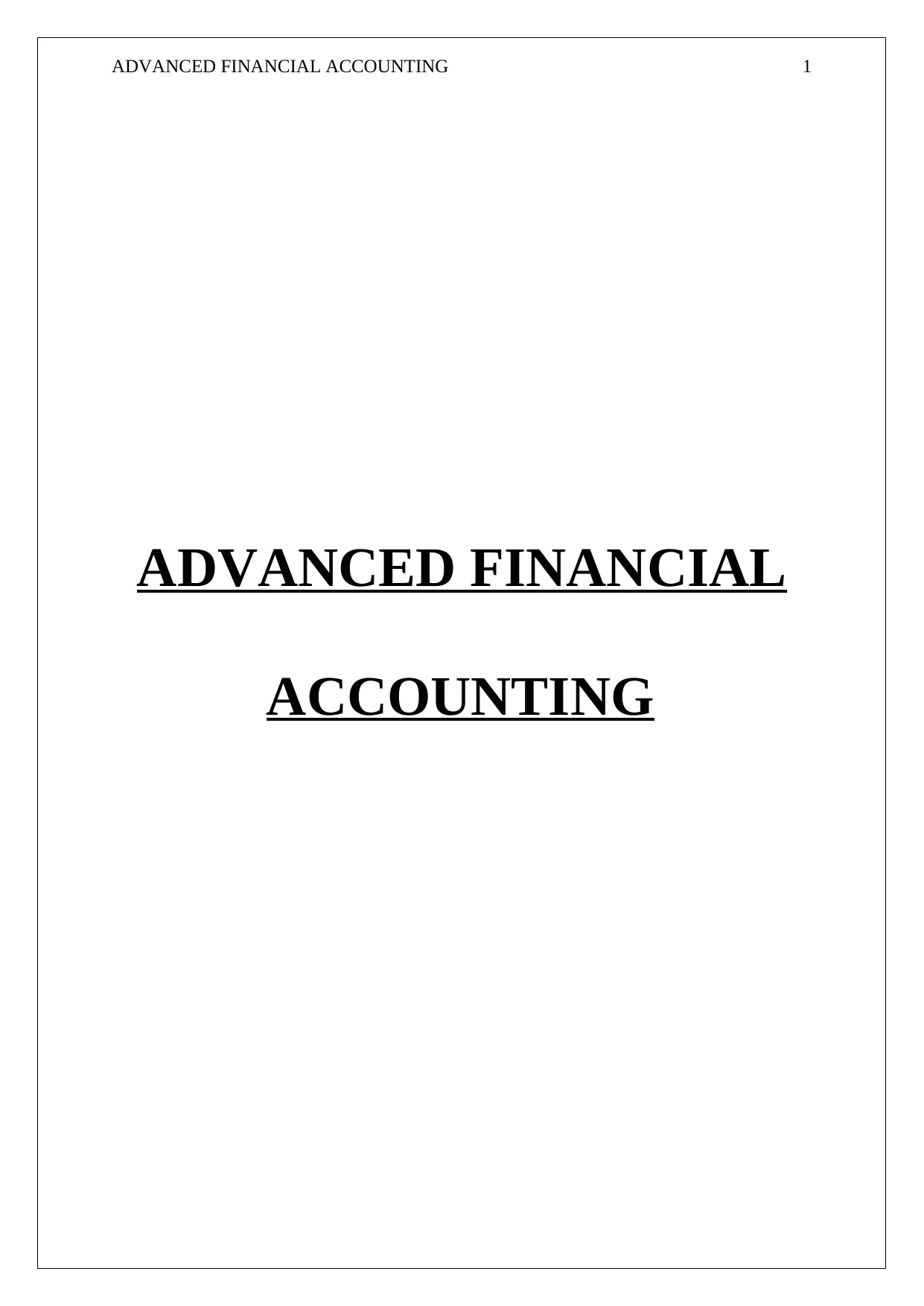
ADVANCED FINANCIAL ACCOUNTING 1
ADVANCED FINANCIAL
ACCOUNTING
ADVANCED FINANCIAL
ACCOUNTING
Paraphrase This Document
Need a fresh take? Get an instant paraphrase of this document with our AI Paraphraser
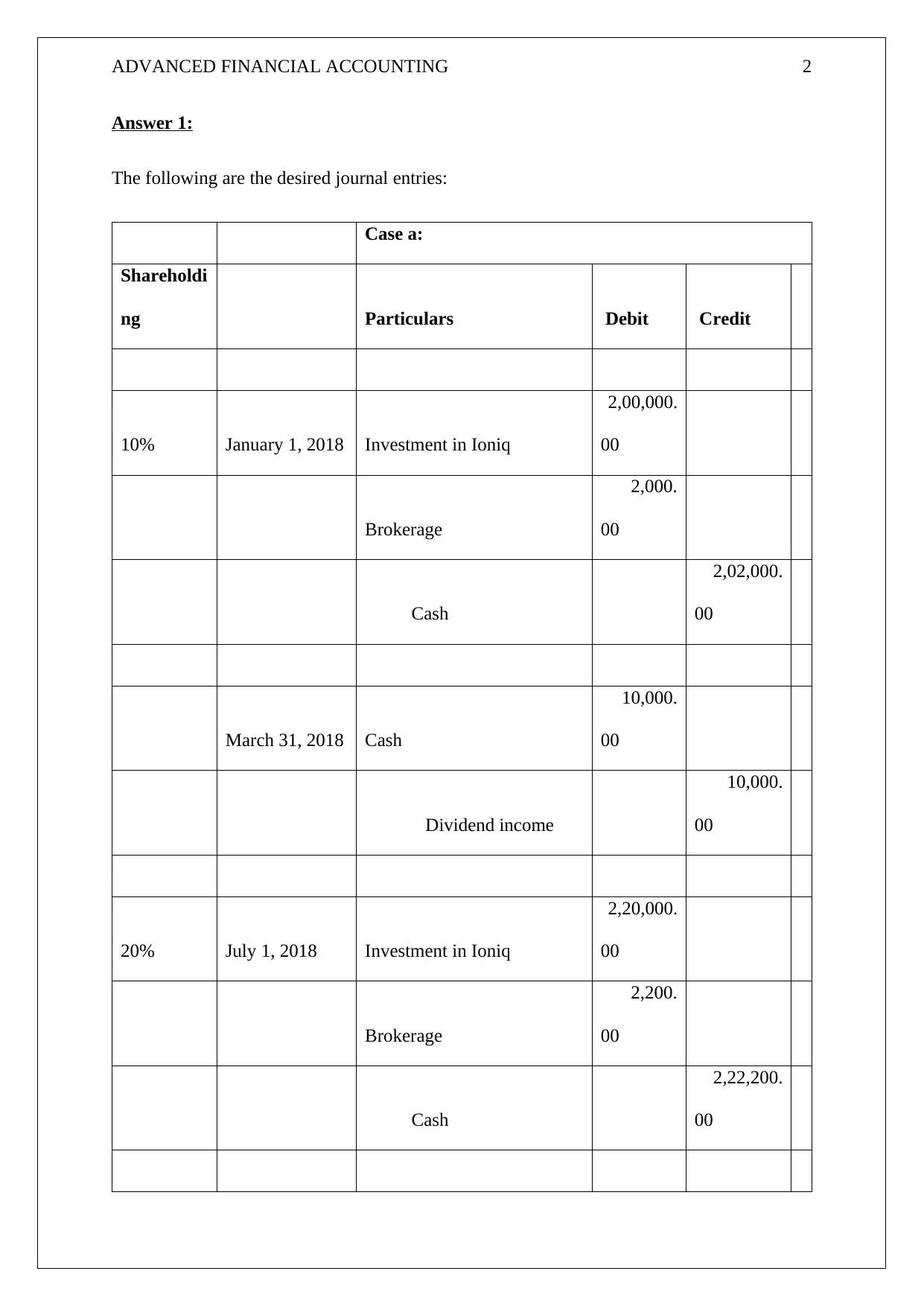
ADVANCED FINANCIAL ACCOUNTING 2
Answer 1:
The following are the desired journal entries:
Case a:
Shareholdi
ng Particulars Debit Credit
10% January 1, 2018 Investment in Ioniq
2,00,000.
00
Brokerage
2,000.
00
Cash
2,02,000.
00
March 31, 2018 Cash
10,000.
00
Dividend income
10,000.
00
20% July 1, 2018 Investment in Ioniq
2,20,000.
00
Brokerage
2,200.
00
Cash
2,22,200.
00
Answer 1:
The following are the desired journal entries:
Case a:
Shareholdi
ng Particulars Debit Credit
10% January 1, 2018 Investment in Ioniq
2,00,000.
00
Brokerage
2,000.
00
Cash
2,02,000.
00
March 31, 2018 Cash
10,000.
00
Dividend income
10,000.
00
20% July 1, 2018 Investment in Ioniq
2,20,000.
00
Brokerage
2,200.
00
Cash
2,22,200.
00

ADVANCED FINANCIAL ACCOUNTING 3
July 1, 2018 Cash
24,000.
00
Dividend income
24,000.
00
November 30,
2018 Cash
2,40,000.
00
Brokerage
2,400.
00
Investment in Ioniq
2,00,000.
00
Profit on sale of
investment
42,400.
00
10%
December 31,
2018 Unrealised gain
50,000.
00
Profit and loss
50,000.
00
December 31,
2018 Investment in Ioniq
24,000.
00
Share of profit
in Ioniq
24,000.
00
July 1, 2018 Cash
24,000.
00
Dividend income
24,000.
00
November 30,
2018 Cash
2,40,000.
00
Brokerage
2,400.
00
Investment in Ioniq
2,00,000.
00
Profit on sale of
investment
42,400.
00
10%
December 31,
2018 Unrealised gain
50,000.
00
Profit and loss
50,000.
00
December 31,
2018 Investment in Ioniq
24,000.
00
Share of profit
in Ioniq
24,000.
00
⊘ This is a preview!⊘
Do you want full access?
Subscribe today to unlock all pages.

Trusted by 1+ million students worldwide
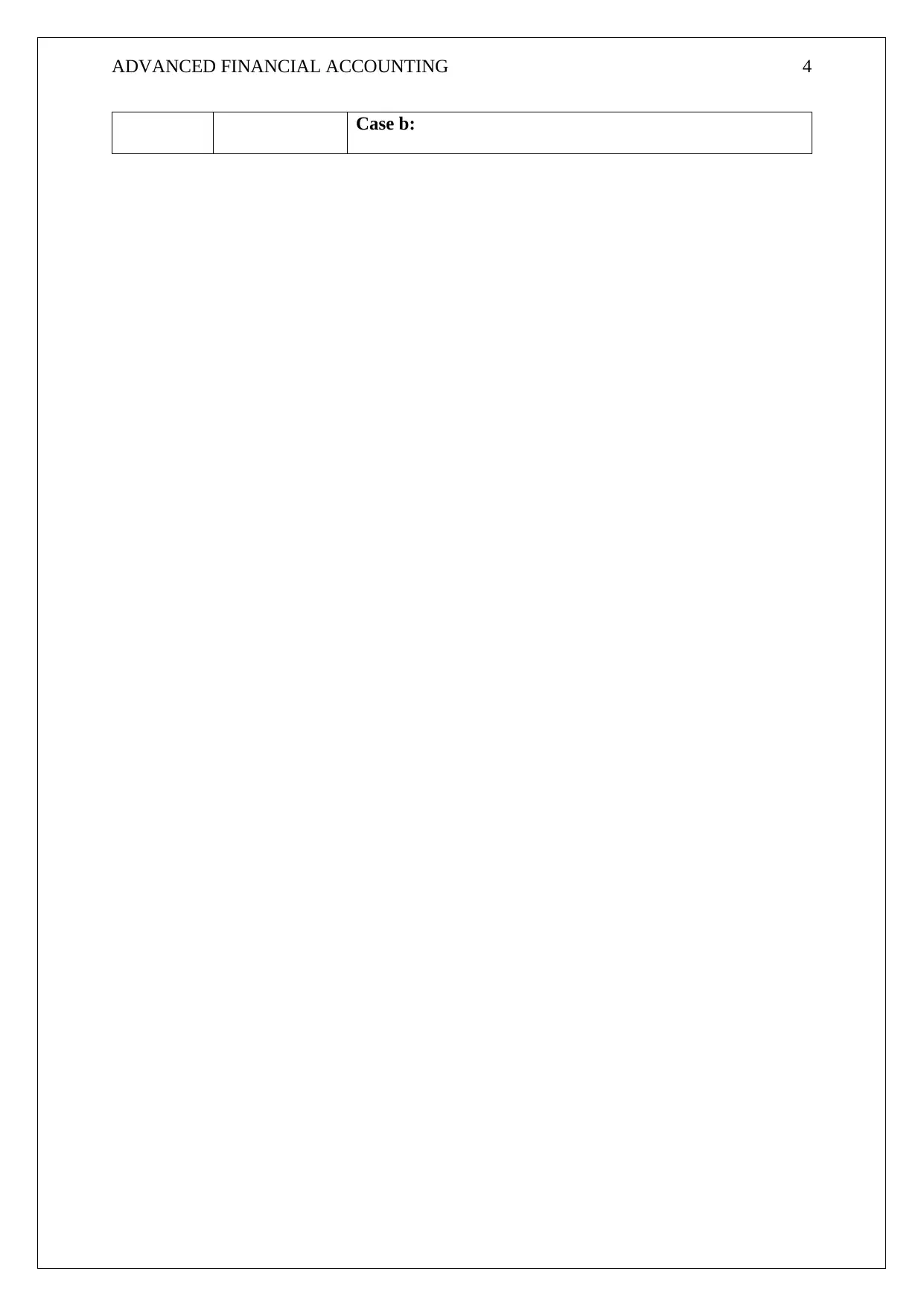
ADVANCED FINANCIAL ACCOUNTING 4
Case b:
Case b:
Paraphrase This Document
Need a fresh take? Get an instant paraphrase of this document with our AI Paraphraser
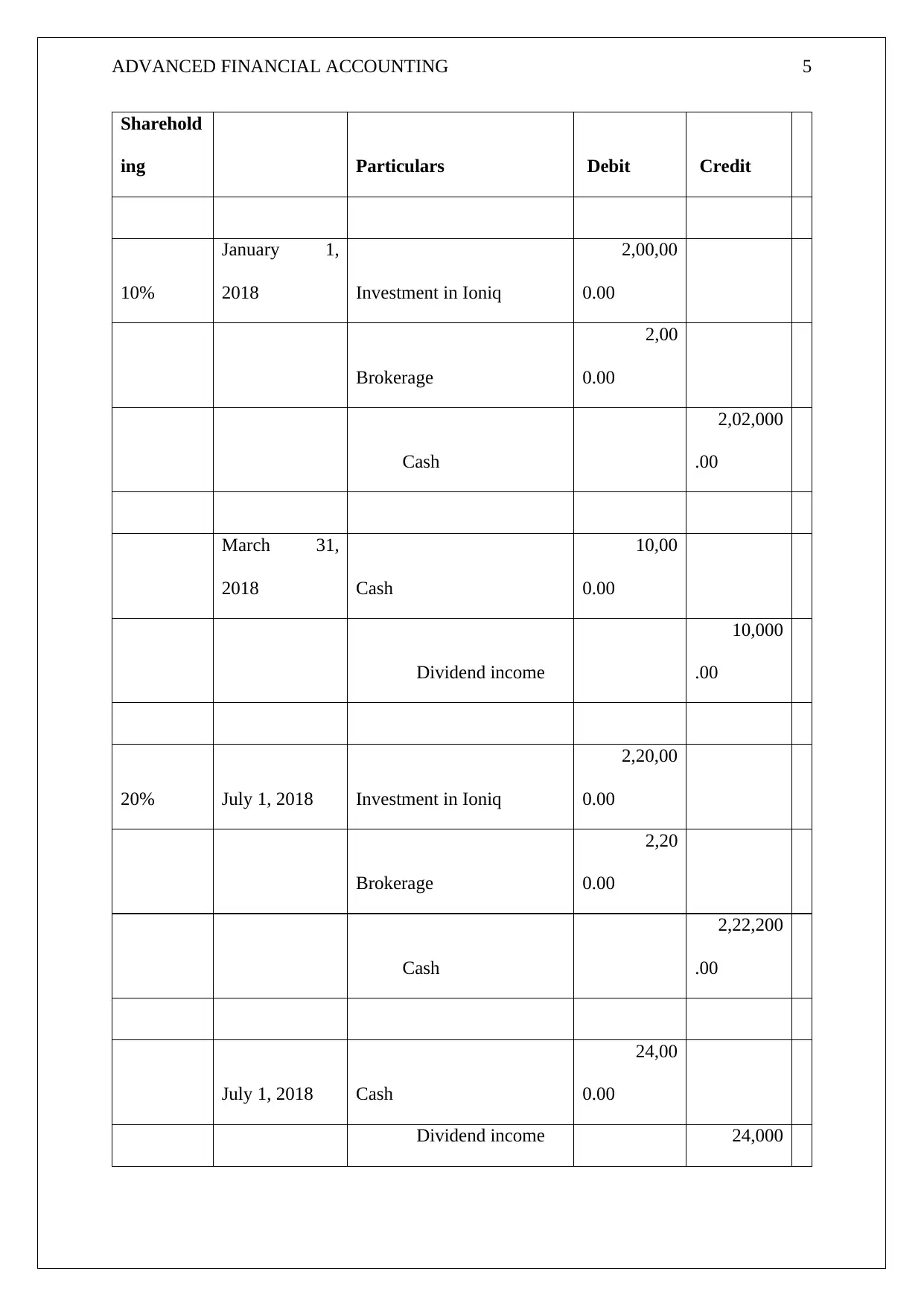
ADVANCED FINANCIAL ACCOUNTING 5
Sharehold
ing Particulars Debit Credit
10%
January 1,
2018 Investment in Ioniq
2,00,00
0.00
Brokerage
2,00
0.00
Cash
2,02,000
.00
March 31,
2018 Cash
10,00
0.00
Dividend income
10,000
.00
20% July 1, 2018 Investment in Ioniq
2,20,00
0.00
Brokerage
2,20
0.00
Cash
2,22,200
.00
July 1, 2018 Cash
24,00
0.00
Dividend income 24,000
Sharehold
ing Particulars Debit Credit
10%
January 1,
2018 Investment in Ioniq
2,00,00
0.00
Brokerage
2,00
0.00
Cash
2,02,000
.00
March 31,
2018 Cash
10,00
0.00
Dividend income
10,000
.00
20% July 1, 2018 Investment in Ioniq
2,20,00
0.00
Brokerage
2,20
0.00
Cash
2,22,200
.00
July 1, 2018 Cash
24,00
0.00
Dividend income 24,000
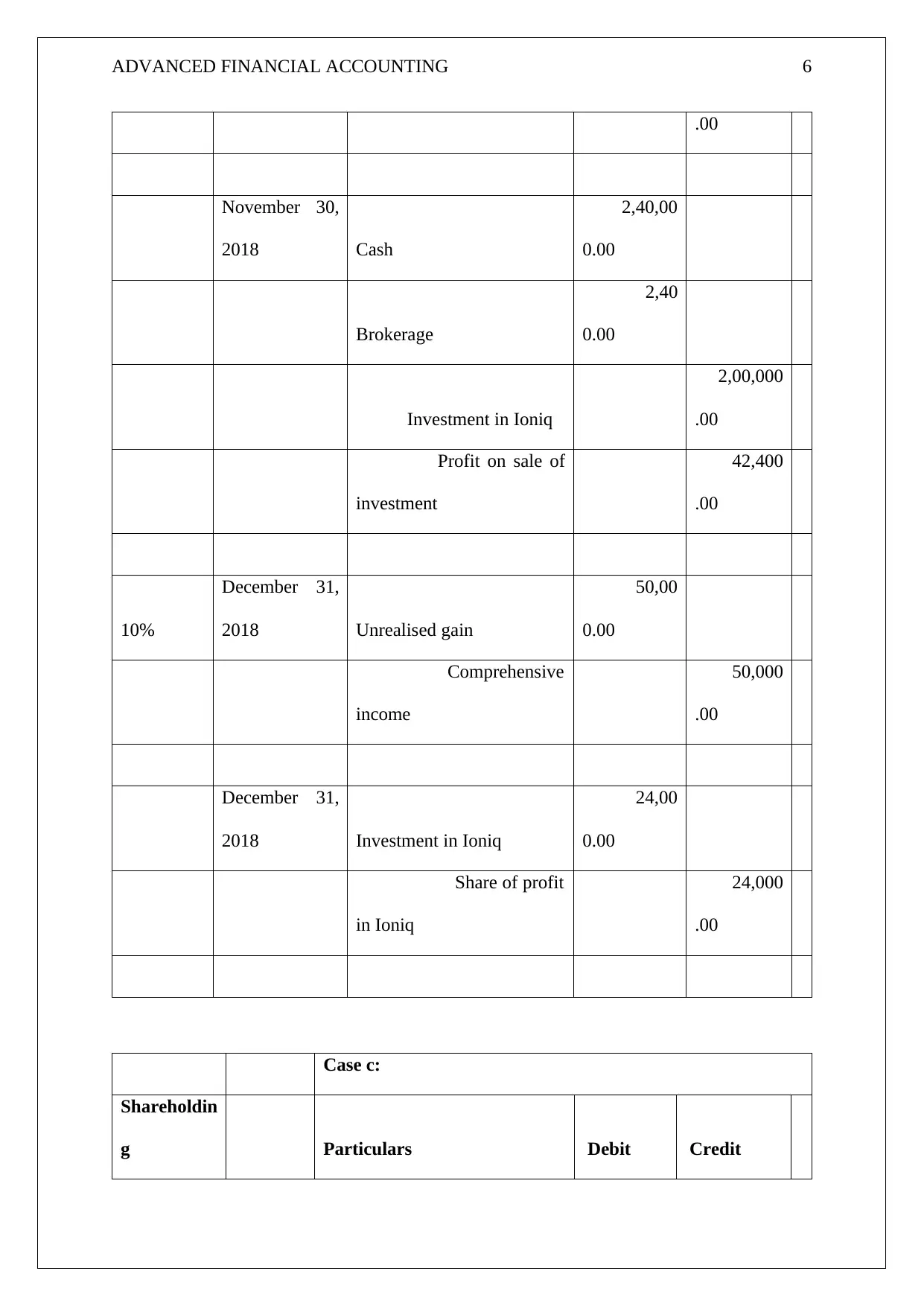
ADVANCED FINANCIAL ACCOUNTING 6
.00
November 30,
2018 Cash
2,40,00
0.00
Brokerage
2,40
0.00
Investment in Ioniq
2,00,000
.00
Profit on sale of
investment
42,400
.00
10%
December 31,
2018 Unrealised gain
50,00
0.00
Comprehensive
income
50,000
.00
December 31,
2018 Investment in Ioniq
24,00
0.00
Share of profit
in Ioniq
24,000
.00
Case c:
Shareholdin
g Particulars Debit Credit
.00
November 30,
2018 Cash
2,40,00
0.00
Brokerage
2,40
0.00
Investment in Ioniq
2,00,000
.00
Profit on sale of
investment
42,400
.00
10%
December 31,
2018 Unrealised gain
50,00
0.00
Comprehensive
income
50,000
.00
December 31,
2018 Investment in Ioniq
24,00
0.00
Share of profit
in Ioniq
24,000
.00
Case c:
Shareholdin
g Particulars Debit Credit
⊘ This is a preview!⊘
Do you want full access?
Subscribe today to unlock all pages.

Trusted by 1+ million students worldwide
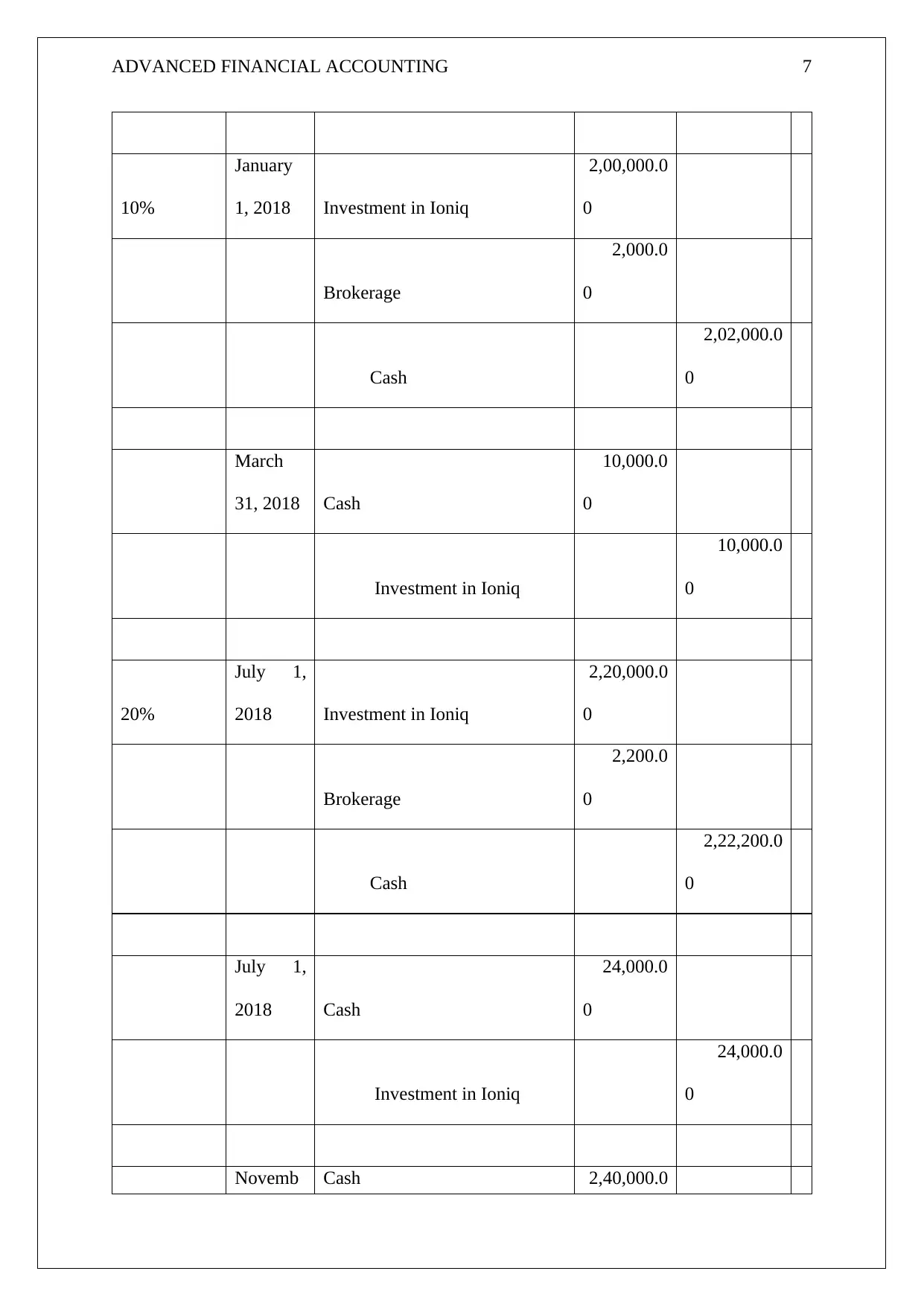
ADVANCED FINANCIAL ACCOUNTING 7
10%
January
1, 2018 Investment in Ioniq
2,00,000.0
0
Brokerage
2,000.0
0
Cash
2,02,000.0
0
March
31, 2018 Cash
10,000.0
0
Investment in Ioniq
10,000.0
0
20%
July 1,
2018 Investment in Ioniq
2,20,000.0
0
Brokerage
2,200.0
0
Cash
2,22,200.0
0
July 1,
2018 Cash
24,000.0
0
Investment in Ioniq
24,000.0
0
Novemb Cash 2,40,000.0
10%
January
1, 2018 Investment in Ioniq
2,00,000.0
0
Brokerage
2,000.0
0
Cash
2,02,000.0
0
March
31, 2018 Cash
10,000.0
0
Investment in Ioniq
10,000.0
0
20%
July 1,
2018 Investment in Ioniq
2,20,000.0
0
Brokerage
2,200.0
0
Cash
2,22,200.0
0
July 1,
2018 Cash
24,000.0
0
Investment in Ioniq
24,000.0
0
Novemb Cash 2,40,000.0
Paraphrase This Document
Need a fresh take? Get an instant paraphrase of this document with our AI Paraphraser
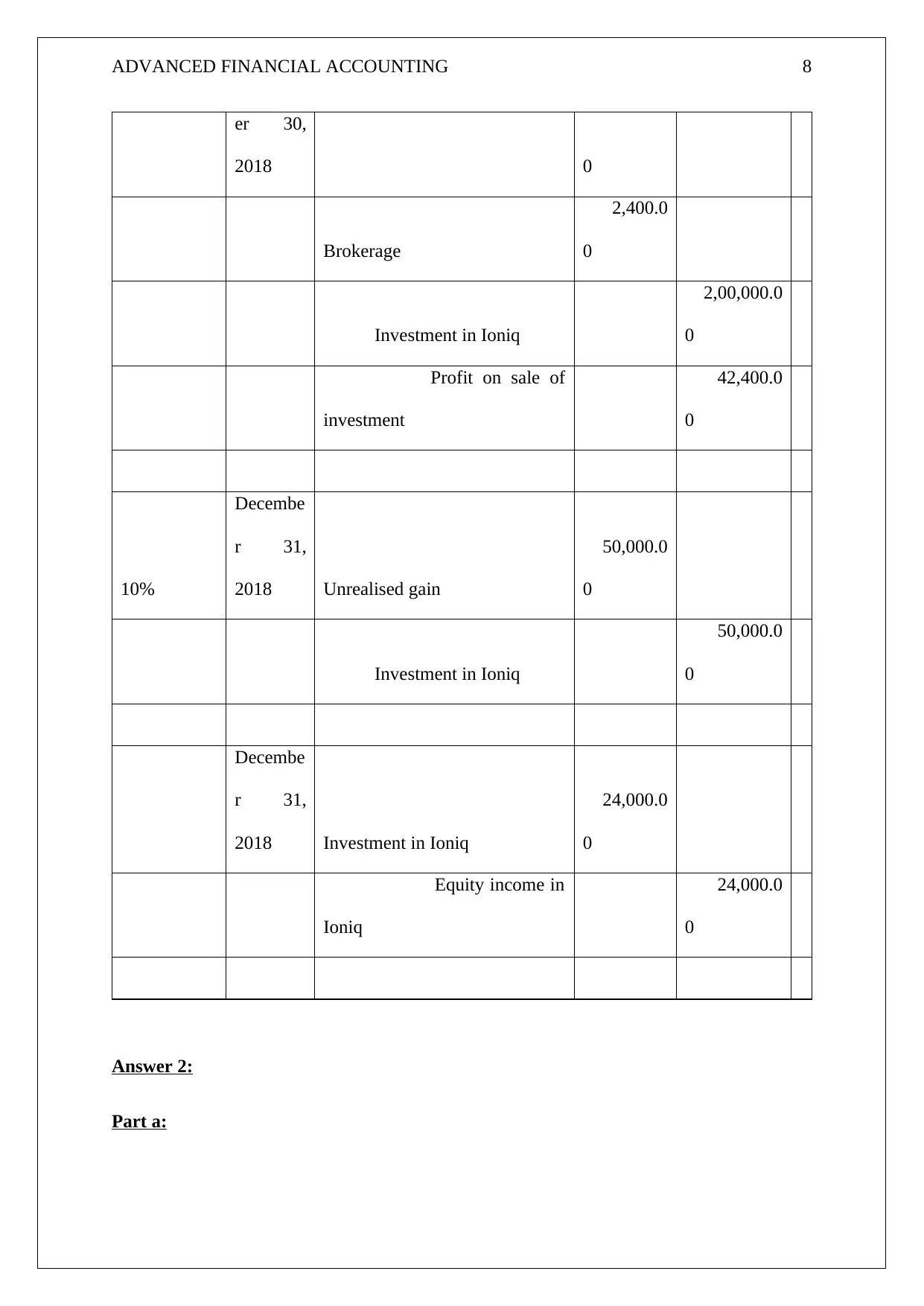
ADVANCED FINANCIAL ACCOUNTING 8
er 30,
2018 0
Brokerage
2,400.0
0
Investment in Ioniq
2,00,000.0
0
Profit on sale of
investment
42,400.0
0
10%
Decembe
r 31,
2018 Unrealised gain
50,000.0
0
Investment in Ioniq
50,000.0
0
Decembe
r 31,
2018 Investment in Ioniq
24,000.0
0
Equity income in
Ioniq
24,000.0
0
Answer 2:
Part a:
er 30,
2018 0
Brokerage
2,400.0
0
Investment in Ioniq
2,00,000.0
0
Profit on sale of
investment
42,400.0
0
10%
Decembe
r 31,
2018 Unrealised gain
50,000.0
0
Investment in Ioniq
50,000.0
0
Decembe
r 31,
2018 Investment in Ioniq
24,000.0
0
Equity income in
Ioniq
24,000.0
0
Answer 2:
Part a:

ADVANCED FINANCIAL ACCOUNTING 9
As per the IFRS 9, any financial instrument is initially measured at their respective fair
values, plus or minus any financial asset or the financial liability nit at its fair value through
the profit and loss or the transactions costs. These are also the requirement as per the IAS 39.
In the area of the financial assets, many changes have been introduced. On the meeting of
some conditions, the assets shall be reclassified. Subsequent to the initial recognition, an asset
will have to be reclassified. All of the assets that come within the scope of IFRS 9 would be
measured at their amortised cost or the fair values through the other comprehensive income
or through the profit or loss.
The accounting of investment at fair values through the other comprehensive income is
mandatory for some debt instruments unless the option of accounting at fair value through
profit or loss is done. There are some of the equity instruments that are classified through the
other comprehensive income. These are the requirements for reclassifying the gains or the
losses that have been recognised in the statement of comprehensive income. The accounting
requirements for the reclassification of the gain or losses that have been recognise din the
other comprehensive income are different for the debt and different for the equity
instruments. For the debt instruments that are measured through the other comprehensive
income, the interest income, the gains or losses occurring due to foreign currency and any
amount of impairment gains or losses shall be recognised in the statement or profit or loss
(IFRS, 2019).
For the equity investments, all of the equity investments shall be measured at their fair value
in the statement of financial position. Any change in the value shall be recognised in the
statement of profit or loss, except from the equity investments for which the company shall
represent the changes in the other comprehensive income.
As per the IFRS 9, any financial instrument is initially measured at their respective fair
values, plus or minus any financial asset or the financial liability nit at its fair value through
the profit and loss or the transactions costs. These are also the requirement as per the IAS 39.
In the area of the financial assets, many changes have been introduced. On the meeting of
some conditions, the assets shall be reclassified. Subsequent to the initial recognition, an asset
will have to be reclassified. All of the assets that come within the scope of IFRS 9 would be
measured at their amortised cost or the fair values through the other comprehensive income
or through the profit or loss.
The accounting of investment at fair values through the other comprehensive income is
mandatory for some debt instruments unless the option of accounting at fair value through
profit or loss is done. There are some of the equity instruments that are classified through the
other comprehensive income. These are the requirements for reclassifying the gains or the
losses that have been recognised in the statement of comprehensive income. The accounting
requirements for the reclassification of the gain or losses that have been recognise din the
other comprehensive income are different for the debt and different for the equity
instruments. For the debt instruments that are measured through the other comprehensive
income, the interest income, the gains or losses occurring due to foreign currency and any
amount of impairment gains or losses shall be recognised in the statement or profit or loss
(IFRS, 2019).
For the equity investments, all of the equity investments shall be measured at their fair value
in the statement of financial position. Any change in the value shall be recognised in the
statement of profit or loss, except from the equity investments for which the company shall
represent the changes in the other comprehensive income.
⊘ This is a preview!⊘
Do you want full access?
Subscribe today to unlock all pages.

Trusted by 1+ million students worldwide
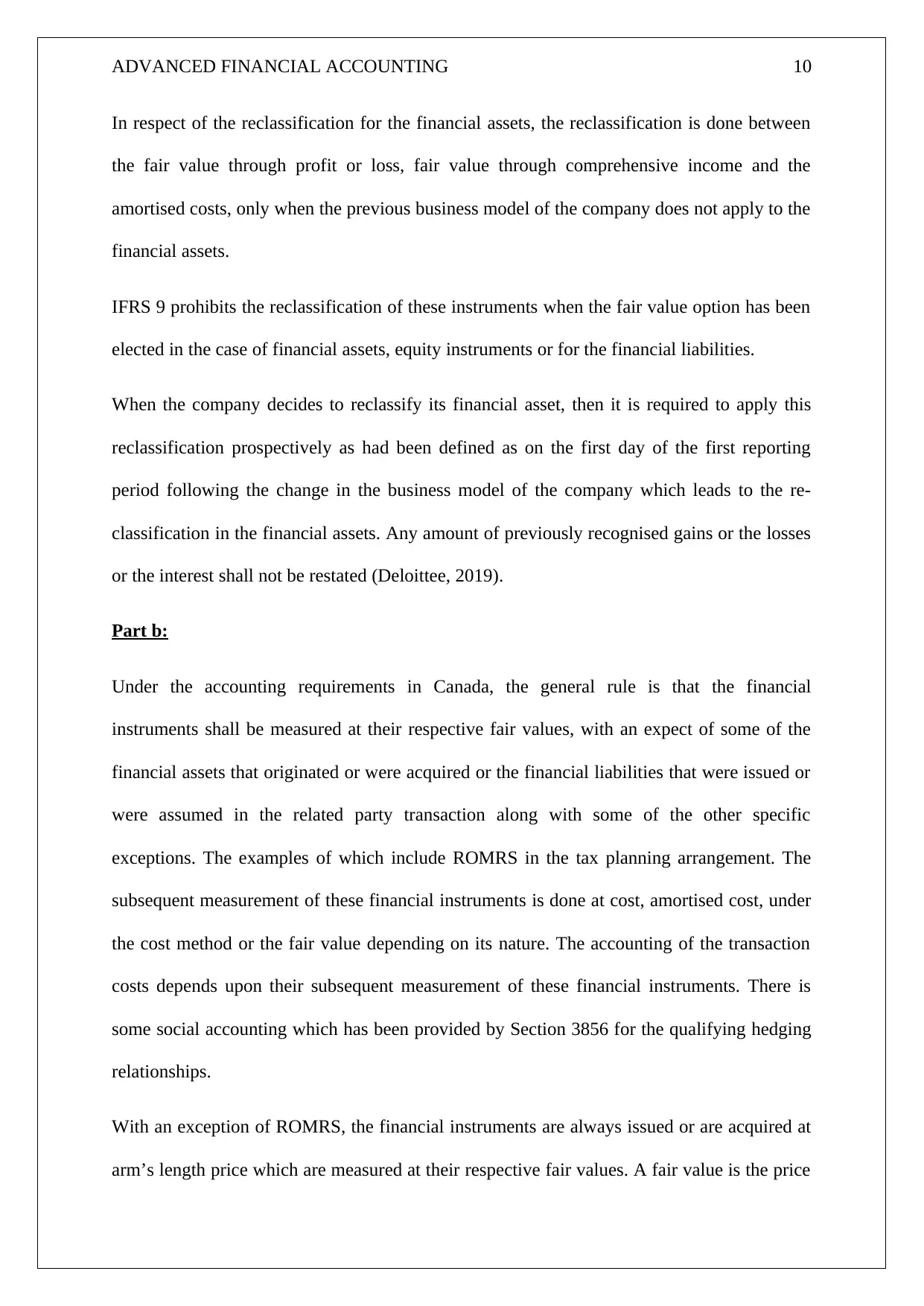
ADVANCED FINANCIAL ACCOUNTING 10
In respect of the reclassification for the financial assets, the reclassification is done between
the fair value through profit or loss, fair value through comprehensive income and the
amortised costs, only when the previous business model of the company does not apply to the
financial assets.
IFRS 9 prohibits the reclassification of these instruments when the fair value option has been
elected in the case of financial assets, equity instruments or for the financial liabilities.
When the company decides to reclassify its financial asset, then it is required to apply this
reclassification prospectively as had been defined as on the first day of the first reporting
period following the change in the business model of the company which leads to the re-
classification in the financial assets. Any amount of previously recognised gains or the losses
or the interest shall not be restated (Deloittee, 2019).
Part b:
Under the accounting requirements in Canada, the general rule is that the financial
instruments shall be measured at their respective fair values, with an expect of some of the
financial assets that originated or were acquired or the financial liabilities that were issued or
were assumed in the related party transaction along with some of the other specific
exceptions. The examples of which include ROMRS in the tax planning arrangement. The
subsequent measurement of these financial instruments is done at cost, amortised cost, under
the cost method or the fair value depending on its nature. The accounting of the transaction
costs depends upon their subsequent measurement of these financial instruments. There is
some social accounting which has been provided by Section 3856 for the qualifying hedging
relationships.
With an exception of ROMRS, the financial instruments are always issued or are acquired at
arm’s length price which are measured at their respective fair values. A fair value is the price
In respect of the reclassification for the financial assets, the reclassification is done between
the fair value through profit or loss, fair value through comprehensive income and the
amortised costs, only when the previous business model of the company does not apply to the
financial assets.
IFRS 9 prohibits the reclassification of these instruments when the fair value option has been
elected in the case of financial assets, equity instruments or for the financial liabilities.
When the company decides to reclassify its financial asset, then it is required to apply this
reclassification prospectively as had been defined as on the first day of the first reporting
period following the change in the business model of the company which leads to the re-
classification in the financial assets. Any amount of previously recognised gains or the losses
or the interest shall not be restated (Deloittee, 2019).
Part b:
Under the accounting requirements in Canada, the general rule is that the financial
instruments shall be measured at their respective fair values, with an expect of some of the
financial assets that originated or were acquired or the financial liabilities that were issued or
were assumed in the related party transaction along with some of the other specific
exceptions. The examples of which include ROMRS in the tax planning arrangement. The
subsequent measurement of these financial instruments is done at cost, amortised cost, under
the cost method or the fair value depending on its nature. The accounting of the transaction
costs depends upon their subsequent measurement of these financial instruments. There is
some social accounting which has been provided by Section 3856 for the qualifying hedging
relationships.
With an exception of ROMRS, the financial instruments are always issued or are acquired at
arm’s length price which are measured at their respective fair values. A fair value is the price
Paraphrase This Document
Need a fresh take? Get an instant paraphrase of this document with our AI Paraphraser
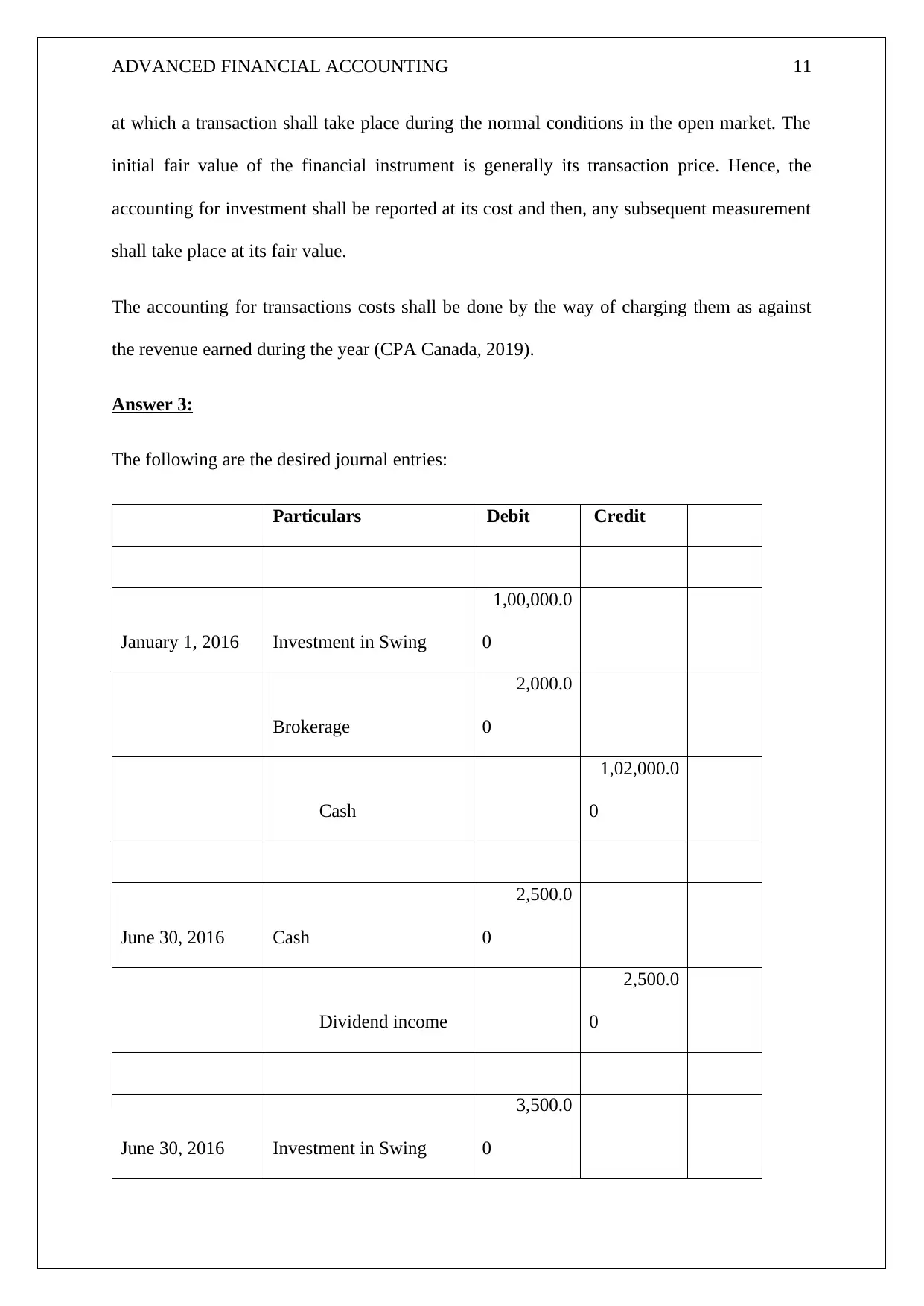
ADVANCED FINANCIAL ACCOUNTING 11
at which a transaction shall take place during the normal conditions in the open market. The
initial fair value of the financial instrument is generally its transaction price. Hence, the
accounting for investment shall be reported at its cost and then, any subsequent measurement
shall take place at its fair value.
The accounting for transactions costs shall be done by the way of charging them as against
the revenue earned during the year (CPA Canada, 2019).
Answer 3:
The following are the desired journal entries:
Particulars Debit Credit
January 1, 2016 Investment in Swing
1,00,000.0
0
Brokerage
2,000.0
0
Cash
1,02,000.0
0
June 30, 2016 Cash
2,500.0
0
Dividend income
2,500.0
0
June 30, 2016 Investment in Swing
3,500.0
0
at which a transaction shall take place during the normal conditions in the open market. The
initial fair value of the financial instrument is generally its transaction price. Hence, the
accounting for investment shall be reported at its cost and then, any subsequent measurement
shall take place at its fair value.
The accounting for transactions costs shall be done by the way of charging them as against
the revenue earned during the year (CPA Canada, 2019).
Answer 3:
The following are the desired journal entries:
Particulars Debit Credit
January 1, 2016 Investment in Swing
1,00,000.0
0
Brokerage
2,000.0
0
Cash
1,02,000.0
0
June 30, 2016 Cash
2,500.0
0
Dividend income
2,500.0
0
June 30, 2016 Investment in Swing
3,500.0
0
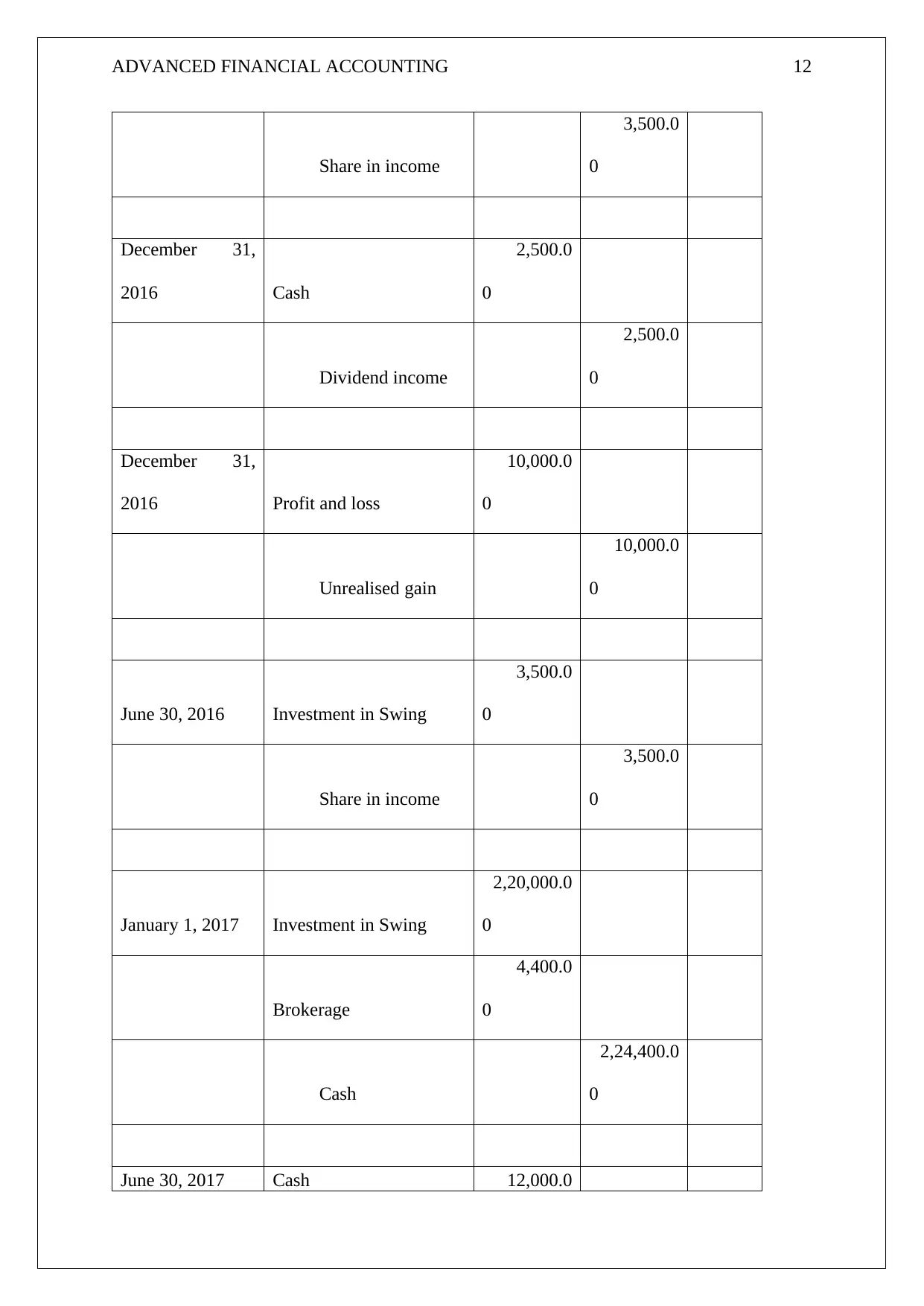
ADVANCED FINANCIAL ACCOUNTING 12
Share in income
3,500.0
0
December 31,
2016 Cash
2,500.0
0
Dividend income
2,500.0
0
December 31,
2016 Profit and loss
10,000.0
0
Unrealised gain
10,000.0
0
June 30, 2016 Investment in Swing
3,500.0
0
Share in income
3,500.0
0
January 1, 2017 Investment in Swing
2,20,000.0
0
Brokerage
4,400.0
0
Cash
2,24,400.0
0
June 30, 2017 Cash 12,000.0
Share in income
3,500.0
0
December 31,
2016 Cash
2,500.0
0
Dividend income
2,500.0
0
December 31,
2016 Profit and loss
10,000.0
0
Unrealised gain
10,000.0
0
June 30, 2016 Investment in Swing
3,500.0
0
Share in income
3,500.0
0
January 1, 2017 Investment in Swing
2,20,000.0
0
Brokerage
4,400.0
0
Cash
2,24,400.0
0
June 30, 2017 Cash 12,000.0
⊘ This is a preview!⊘
Do you want full access?
Subscribe today to unlock all pages.

Trusted by 1+ million students worldwide
1 out of 17
Your All-in-One AI-Powered Toolkit for Academic Success.
+13062052269
info@desklib.com
Available 24*7 on WhatsApp / Email
![[object Object]](/_next/static/media/star-bottom.7253800d.svg)
Unlock your academic potential
Copyright © 2020–2025 A2Z Services. All Rights Reserved. Developed and managed by ZUCOL.
